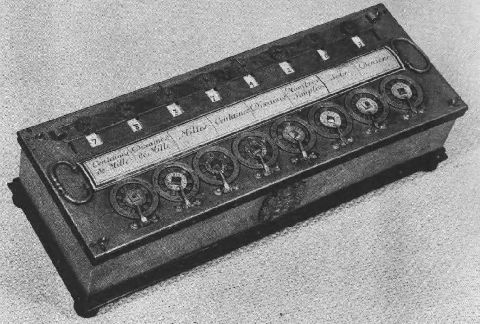
The development of computers over the last few decades has been very rapid. While there are better sources out there for examining any aspect of the computer revolution in detail, this page provides a very brief overview of some of the major milestones in computing history to provide some historical perspective.
In a section of this site devoted to a homage to the computer front panel, there is some additional material giving detail on some segments of the history of computers. On this page and the one following, drawings of the front panels of the various models in the IBM System/360 range give the history of those computers, and on this page and the one following, the computers of the Digital Equipment Corporation are described and discussed. As well, this page in the section on the computer keyboard discusses the IBM PC and some of its early successors, specifically the IBM PCjr and the IBM PC AT, because each of them brought in a new style of keyboard.
Since the dawn of civilization, people have had to do arithmetic, and it was an irksome and error-prone task.
In Mesopotamia, an early form of the abacus was in use in 2300 BC or earlier; in several cultures, the abacus was in use by 600 to 200 BC.
Napier's first publication describing logarithms and their use as an aid to calculation dates from 1614; William Oughtred invented the slide rule in 1622, which made their use for multiplication to limited precision convenient.
The first mechanical adding machines were invented by Pascal and Schickard in 1642. This type of adding machine is sometimes still seen for sale in grocery stores, in a version made out of plastic; it could only add and subtract. A photograph is shown below:

Gottfried Wilhelm Leibniz, also known for having invented Calculus independently of Newton, and devising the notation for it that we still use today, devised a calculating device known as the "stepped reckoner" which used gears having the form of a cylindrical drum, with nine teeth of different lengths, so that either none of them, or any number from one to nine of them, could be engaged; this allowed multiplication, and Leibniz' mechanism could also divide and take square roots. A drawing of this general type of gear, as used in a more modern calculator, is shown below:

The picture below is of the last surviving specimen of the two prototypes that were originally made, kept in a museum in Hanover; it comes from an old German encyclopedia of mathematics:

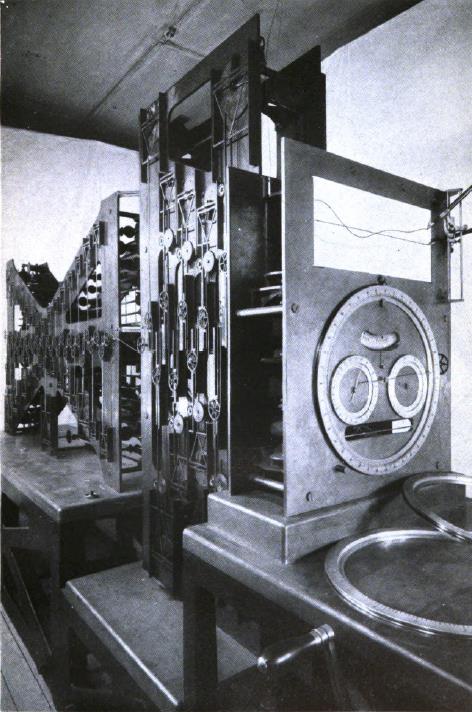
Another early calculating device, analog rather than digital in nature, is a tide predictor.
Shown at left is the Tide Predictor No. 2 of the United States Coast and Geodetic Survey. It involves a great many pulleys, so that it can add the multiple sine-wave components of the tides for any given location for which the values of these components have been previously worked out.
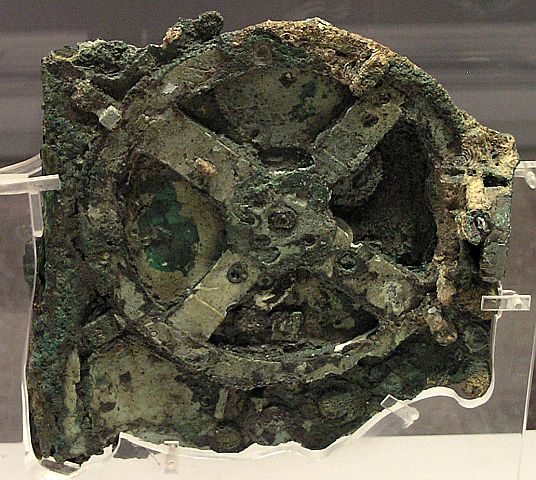 |
The image above is from Wikimedia Commons, licensed under the Creative Commons Attribution Share-Alike 3.0 Unported License, and is thus available for your use under the same terms. Its author is Marsyas. |
Of course, if I am going to mention any analog computational device from the distant past, surely I should not forget to mention what is perhaps the most famous one, from ancient times, the Antikythera mechanism.
This geared device has been found, through careful study, to have been able to show the approximate positions of the planets and the Moon for any selected date (within, of course, a reasonable period of its manufacture) by turning a crank to select the date.
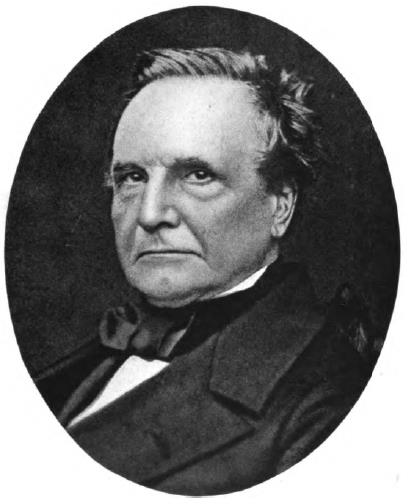

The first attempt at what we think of today as a computer, based on mechanical calculator technology, was, of course, the Analytical Engine by Charles Babbage, first described in 1837, whose portrait is shown at left. The surviving portion of the Difference Engine, which is on display at the South Kensington Museum in London, is shown at right, in an image from The Strand Magazine for June of 1896.
Also notable as an early innovator was Percy Ludgate. He designed a mechanical Analytical Engine independently of Babbage. Although only descriptions of the principles of his machine survive, these embodied important ideas.
Multiplication was enhanced by using a scheme referred to as index numbers to access elements of a multiplication table, instead of simply repeating addition.
Division was also speeded up by use of a table. To divide p by q, both p and q were multiplied by an approximate reciprocal of q from a table. The product of q and the approximate reciprocal, being close to 1, could have its reciprocal in turn calculated to a high accuracy by a series derived from the binomial theorem, and multiplying that reciprocal by the product of p and the approximate reciprocal of q produces a sufficiently accurate approximation to the quotient as to be used as the result.
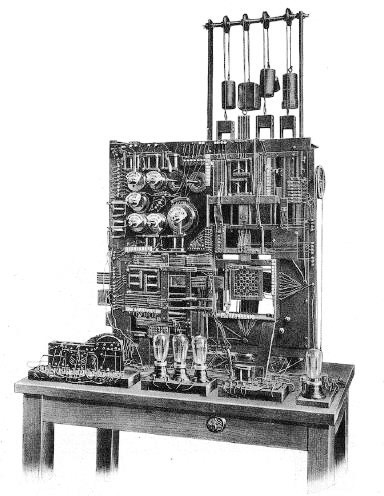
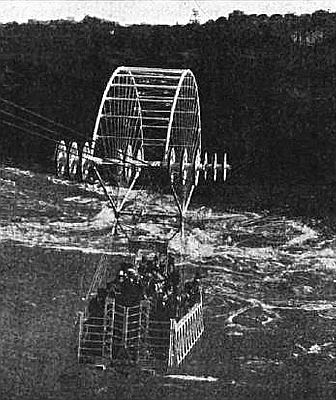
While Charles Babbage's Analytical Engine may seem so impractical that it could not have avoided its eventual failure even under more favorable circumstances, the same cannot be said of the later project of his contemporary, Leonardo Torres y Quevedo, who envisaged building an electrical computer using relays. Leonardo Torres y Quevedo is best known, at least in the English-speaking world, for the demonstration machine he built to generate interest in, and raise money for, his computer project, a machine that could play a simple Chess endgame, first demonstrated in 1914, pictured at left.
He was also a prolific inventor; for example, a device he called the Telekine first demonstrated remote-control by means of radio signals. As well, he has a Canadian connection: he was the designer of the Whirlpool Aero Cable Car, which is still in operation to give tourists an exciting view of a whirlpool some three miles downstream of Niagara Falls.
The cable car is pictured at right.
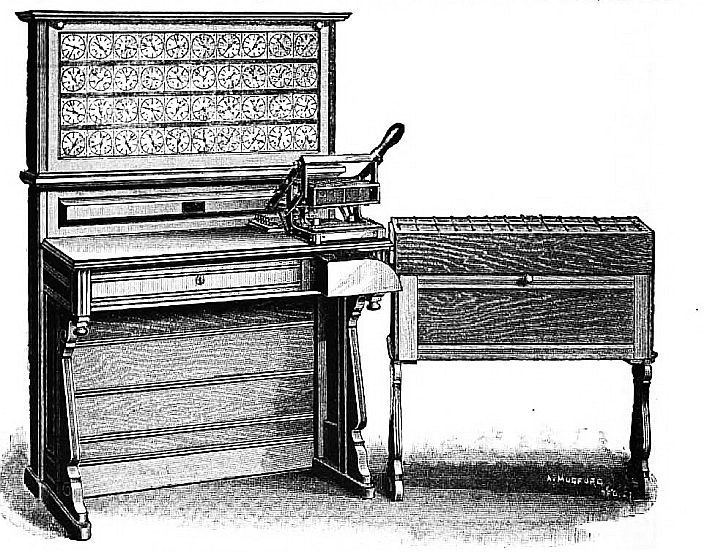
Tabulating equipment using punched cards gradually developed so as to perform some calculating functions. The punched card was invented by Herman Hollerith, who founded a company in 1896 which became the Tabulating Machine Company. This company and three others, the Computing Scale Company of America, the International Time Recording Company, and the Bundy Manufacturing Company, were acquired by Charles R. Flint, and combined to form the Computing-Tabulating-Recording Company in 1911.
The image at right is a contemporary engraving of the Hollerith tabulator (on the left) and a sorting box (on the right) as first used in the United States Census.
Thomas J. Watson succeded to the helm of C-T-R in 1924, and in that year renamed it to International Business Machines. Prior to working for C-T-R, he was a salesman with National Cash Register; it seems obvious to me that his intention in coining the new name for his company was to favorably contrast IBM with NCR; its business is International in scope, not merely National - and it sells every type of Business Machine, not merely Cash Registers!
As well, just as older NCR products bore a logo consisting of the word "National" and a gear, older IBM products also just bore the word "International".
In the 1950s and early 1960s, popular works on the computer would often note that there were two fundamental kinds of computer, the digital computer and the analog computer. Today, when we think of computers, we generally only think of digital computers, because they can do all sorts of fun and exciting things.
Analog computers, like slide rules, are limited in the precision of the numbers they work with. They were used to solve complicated equations which would have been too expensive to solve more precisely on the digital computers available at the time.
A famous mechanical analog computer was the Differential Analyzer, constructed by Vannevar Bush starting in 1927. It makes a brief cameo in the movie "When Worlds Collide". One key component involved a wheel that was driven by a rotating disk; as the wheel could be moved do different positions on the disk, changing the effective gear ratio (somewhat the way some automatic transmissions work) it was used to calculate the integral of a function. A famous photograph of Vannevar Bush himself at the Differential Analyzer is shown below:
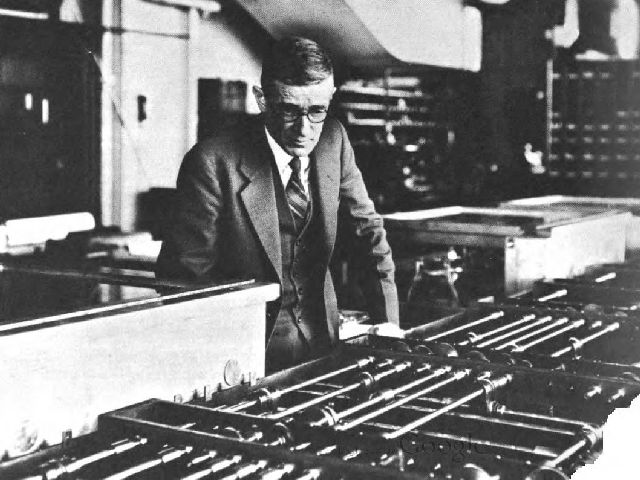
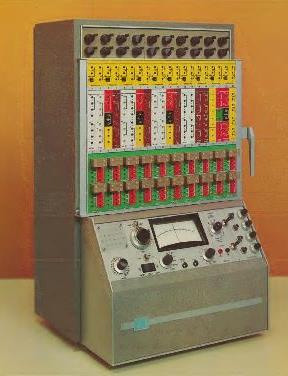
In the 1950s and early 1960s, electronic analog computers which connected operational amplifiers and other electronic components together with patch cords were commercially available. On the right, an example of such a computer is pictured, the PACE TR20 from EAI, one of the smallest electronic analog computers ever made. It was the successor to their TR10, advertised in 1959 as the first fully-transistorized analog computer.
Pictured below is an analog computer of more typical size, the EAI Hydac 2000. This is actually a hybrid computer, including a digital computer as well as an analog computer, working together for greater versatility.

It seems appropriate to discuss the Digital Differential Analyzer at this point. It is a type of digital computer, but instead of running from a stored program, it is essentially the digital equivalent of an analog computer, with digital voltages replaced by streams of numbers in digital form. This type of machine existed both as a standalone computing system, and as an accessory for a digital computer.
Here is a photograph of a Bendix G-15, a computer system that will be discussed later on this page. But in this photograph, it has an important accessory to the right of it, the DA-1. This was a digital differential analyzer which could be connected to the G-15 in order to make use of its drum memory.
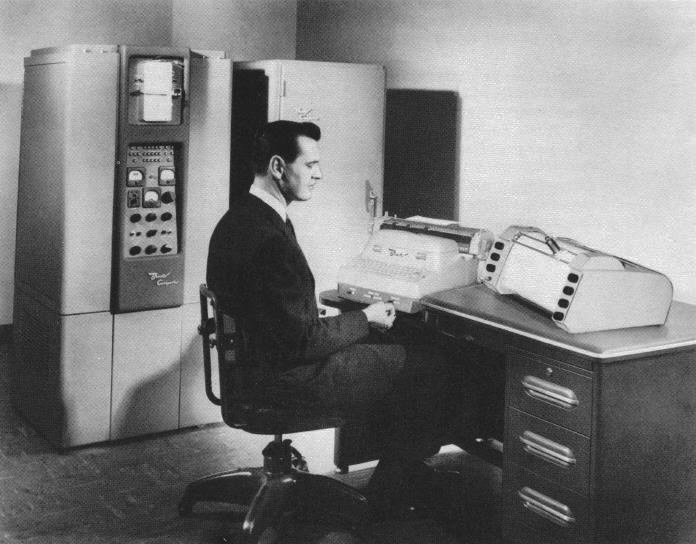
The plotter on the right of the console typewriter in the photo is there specifically to record the output of the DDA, like the one we see in the photograph of the MADDIDA below.
A digital differential analyzer was an early type of special-purpose computer designed to perform one type of calculation efficiently that was well-fitted to the limitations of the drum memory used in many computers at the time. As long as multiple vectors were suitably placed on the drum, it could perform calculations on the multiple incoming streams of numbers which would correspond to the operations performed on electrical signals in an analog computer.
A number of early computers offered a digital differential analyzer as a possible accessory. The first digital differential analyzer, however, was a standalone unit, MADDIDA, for MAgnetic Drum DIgital Differential Analyzer, offered by Northrop Aviation, and pictured below. In this image, you can see the MADDIDA itself, an oscilloscope sitting on top of it, some additional electronics to its right, and a plotter. As well, further to the right is a second MADDIDA in the background of the photograph.
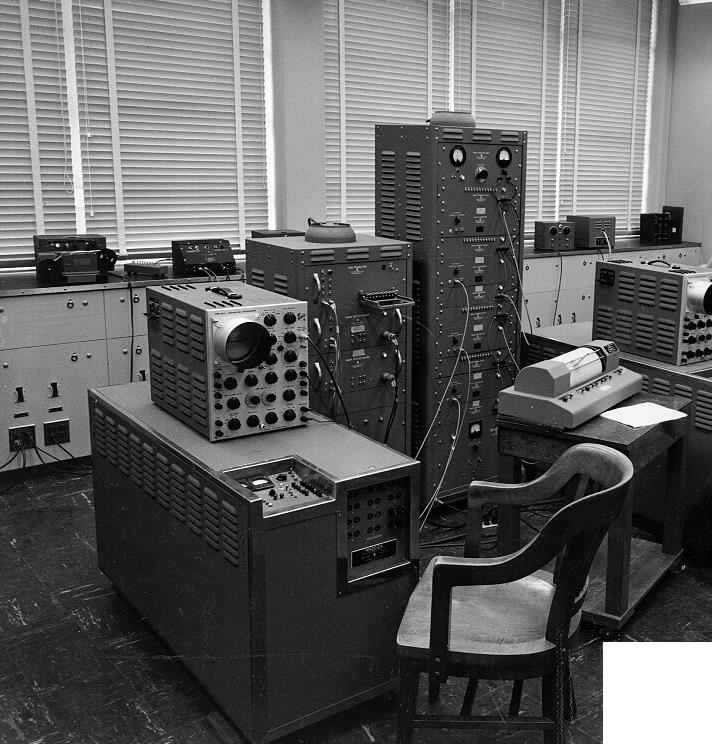
The Packard-Bell TRICE, pictured below,

was also a digital differential analyzer; it could be part of a system which included either a Packard-Bell PB250 or a Packard-Bell PB440 as its digital computer, and a Mark III Analog Computer which was made by Computer Products Incorporated instead of Packard Bell. This hybrid analog/digital computer system was called the Hycomp; configurations involving a smaller analog computer with a PB250 and without the TRICE DDA also existed. The analog computer in those configurations could have been a T-50 also from Computer Products Incorporated, or a TR10 or TR48 from EAI, among others.
Note that the Packard-Bell PB440 computer used core memory, and not a drum; the TRICE, unlike other digital differential analyzers, performed operations in a parallel fashion for higher speed, rather than in the fully-serial manner of the traditional DDA.
Although digital differential analyzers are no longer in common use as a type of computer, the principle has on occasion been employed subsequently for such applications as a system for rapidly drawing curves for computer graphics.
One interesting system that also may be mentioned here is the Differential Equation Solver, DES-1, for the SDS 9300 computer. This was primarily a software package, which allowed an SDS 9300 equipped with the hardware floating-point option to simulate an analog computer; but it did include one hardware component, an additional control panel for the computer with which this software interacted. The SDS 9300 was a relatively powerful 24-bit computer made from discrete transistors.

On the left is a photograph of a relay, from an advertisement by Cornell-Dubilier.
At the bottom is a coil, which when energized, acts as an electromagnet, pulling a piece of magnetic material towards one of its poles, causing a lever to move contacts that are at the ends of flexible strips of metal, which we see at the top of the photograph.
Relays, which can obviously act as logic elements, were around for quite some time before computers were built with them, although the idea had occurred to Torres y Quevedo many years before this actually happened.
The Harvard Mark I, conceived in 1939, used a program on a punched paper tape to control calculations performed with electromechanical relays. It became operational in 1944. As initially designed, it did not have a conditional branch instruction. Howard Aiken, its designer, referred to it as "Babbage's dream come true", which shows that Charles Babbage's work did not get rediscovered after the computer age was in full swing, as has occasionally been claimed. The cost of building this computer was largely borne by IBM.
Here is an IBM photograph of this computer:
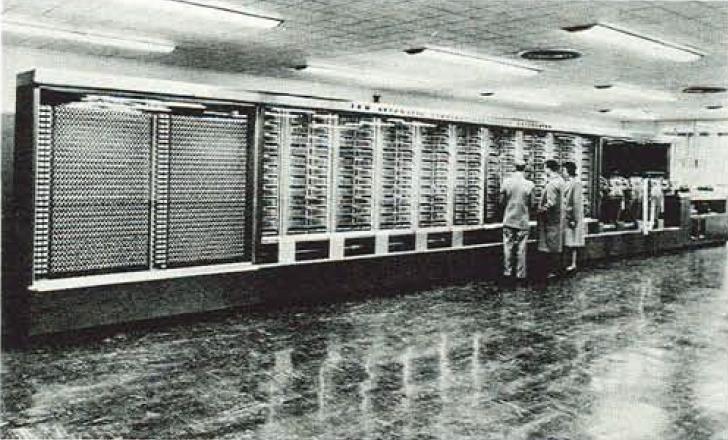
Personally, I view the Harvard Mark I as "the first computer", to the extent that such a term has any meaning. It used relays instead of vacuum tubes, but I view that as a distinction as trivial as the fact that later computers would use transistors instead of vacuum tubes. In both cases, using a newer, faster kind of controlled switch was "an obvious improvement in the art", as patent lawyers say.
Because it recieved widespread publicity, it was influential. This is unlike the pioneering work of Konrad Zuse, which was obscure for many years because of where and when it took place, and it is unlike the specialized codebreaking device COLOSSUS, which, as it was used for cryptographic purposes, remained secret for decades after it was used.
The Harvard Mark I was a general-purpose device that did useful work which included numerical calculations, which was made known to the general public. Therefore, it was the device that made it clear that such a thing as a computer existed, and that it was something that was very useful. So to me, it is clear that this was where the ball started rolling, and not elsewhere.
The ENIAC was the first well-known fully electronic computer. Its completion was announced on February 14, 1946, after having been secretly constructed during World War II. It was originally programmed through plugging patch cords. A classic photograph of it is shown below:
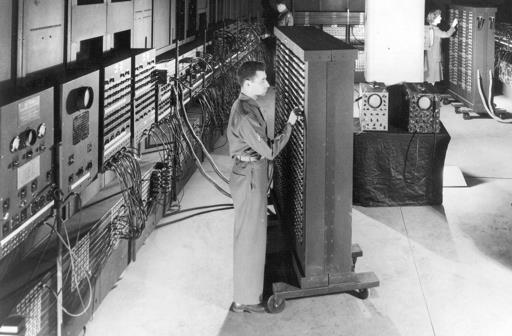
One of its components was an array of dials in which a table of values for a function to be used could be set up; John von Neumann developed a patch cord program that let the machine execute a program entered on those dials. This reduced the speed of the machine's computations, but it drastically shortened the amount of time it took to set the machine up for work on a different problem.
Prior to this, the task of programming the ENIAC was carried out by six women, who remained relatively unknown until recently: Kathleen Antonelli, Jean Bartik, Betty Holberton, Marlyn Meltzer, Frances Spence, and Ruth Titelbaum.
Two other electronic computers that preceded the ENIAC, but were much less well-known than it was, were also influential to an extent despite that.
During the Second World War, in Britain, an electronic device codenamed COLOSSUS assisted in decrypting messages enciphered by German forces on the Lorenz Schlusselzusats machine. Despite this device's existence and use being shrouded in the deepest secrecy, which did not end until 1974 with the publication of The Ultra Secret by F. W. Winterbotham, it still had an influence, because the engineer in charge of building COLOSSUS, Tommy Flowers, subsequently used his knowledge of digital electronics in the early British computer industry.
As COLOSSUS did little more than count the number of times the bits punched on two paper tapes read photoelectrically corresponded, it may not be appropriate to call it a computer. But as it was extremely valuable and useful, that is often overlooked.
The other one I will mention here was not secret. It was mentioned, for example, in a news story in the January 15, 1941 issue of the Des Moines Register.
Professor John Vincent Atanasoff, and his graduate student Clifford Berry, starting in 1937, devised an electronic machine that could solve systems of up to 29 linear equations. It was first operational in 1942, and did useful work, solving a number of problems submitted by George W. Snedecor, the head of the Statistics department at Iowa State University, for example.
The priority of what later became known as the Atanasoff-Berry Computer (ABC) over the ENIAC became an issue in a trial that took place from 1967 to 1973. The patent on the ENIAC had been filed by J. Presper Eckert and John Mauchly, and John Mauchly had paid a visit to the earlier in the same month when that patent was filed.
Univac had acquired the rights to the ENIAC patent. It had entered into a cross-licensing agreement with IBM; and, subsequently, it sought royalties from anyone else who manufactured computers. This began with a lawsuit against Honeywell. The ABC was one of the factors that led to the ENIAC patent being invalidated in the verdict of that case.
IBM was already a large company in the field of data processing before the computer, having been built on Herman Hollerith's company that made punched-card equipment. Before it began selling and leasing computers, it offered advanced calculating devices derived from its punched card equipment that were also capable of extensive automatic calculations.
A little-known early device in this category, of which only a few were made, and initially made for the U.S. military, was the Pluggable Sequence Relay Calculator.
Although based on relays, and small in scale, it was fairly fast, being able to calculate more quickly than the Harvard Mark I.
The IBM 604 Electronic Calculating Punch, which used vacuum tubes instead, is said to have been similar to, and hence a successor of, the Pluggable Sequence Relay Calculator; this device was available as part of IBM's standard product line.
And then, as IBM learned that its customers had been connecting together some of its more capable punched-card processing devices together to achieve greater capabilities - an effort at Northrop Aircraft is most often cited, but one web page notes that there was a previous and very similar attempt at Columbia University - it offered the Card Programmed Calculator itself. This device still had plugboards, which were used in conjunction with punched cards controlling the steps in a calculation. Here is a photograph of the Card-Programmed Calculator:
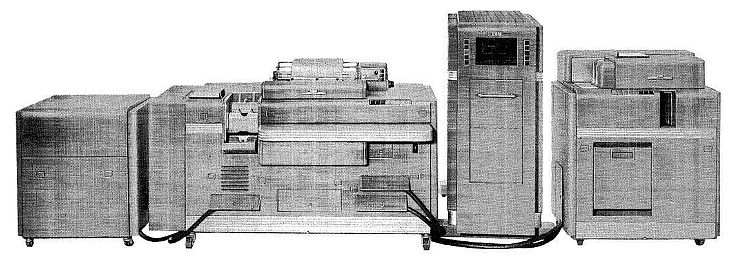
The components, from left to right, visible in this photograph are:
Soon afterwards, many computers were developed that used vacuum tubes to calculate electronically that were much smaller than ENIAC, based on the stored-program concept that John von Neumann had pioneered. Some were still large, like the Univac I, and some were small, like the Bendix G-15.
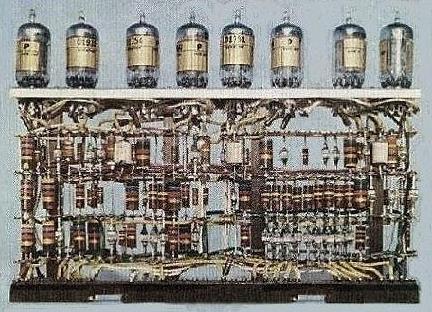
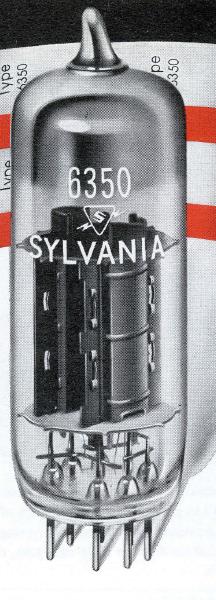
At right is a photograph, from an advertisement, of a twin-triode tube from Sylvania designed for use in computers, and at left is another photograph, from another advertisement, of a circuit module with vacuum tubes used in the IBM 701 computer. While IBM manufactured its own vacuum tubes for its computers because initially vacuum tube companies were unprepared to meet its demanding standards for reliability, later on Sylvania and General Electric, no doubt among others, produced lines of vacuum tubes specifically designed for use within computers.
Since computers deal in digital signals, while they need high-quality tubes in the area of reliability, they don't require tubes that will amplify signals in a linear fashion with low harmonic distortion. That's why a twin-triode tube is a particularly appropriate type of tube to use for computer logic, as it packs the equivalent of two tubes in the space of one.
Von Neumann himself planned to go on from his work on the ENIAC to create a computer designed around the stored program concept, the EDVAC. As it happened, a British group based at the University of Cambridge was the first to complete a computer based on the EDVAC design, the EDSAC, in May, 1949; the month after, the Manchester Mark I was completed: however, a year before, in June, 1948, the Manchester group had a prototype machine working, giving them the honor of building the world's first stored-program electronic computer, as the SSEC, now realized to have been, at least to a limited extent, a stored-program computer which preceded it, was still partly electromechanical.
The Manchester prototype machine used a cathode-ray tube for storage; this is why such a tube is called a Williams tube, after Frederic C. Williams, one of those who worked on that computer. The EDSAC, on the other hand, used mercury delay lines.
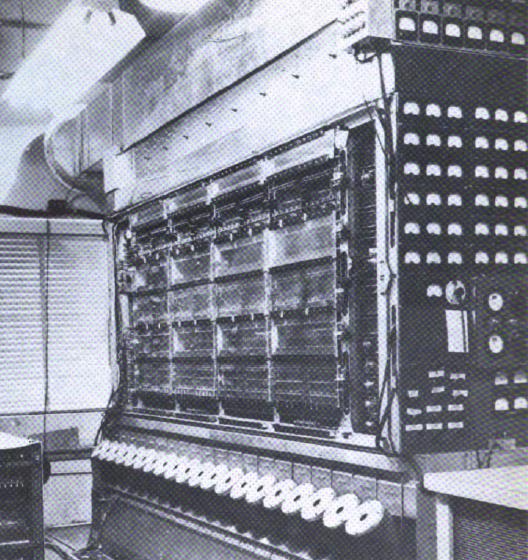
After the EDVAC, John von Neumann worked on the design of a computer at Princeton University's Institute for Advanced Study which was simply known as the IAS Machine. This computer is pictured at left. At the bottom of the image, one can see the line of Williams tubes which formed its random-access memory of 1,024 words of 40 bits each; it also had a magnetic drum providing an additional 16,384 words of storage.
Construction started on the machine in 1945, but it only became fully operational on June 10, 1952.
In 1946, a detailed description of the organization of the machine, entitled Preliminary Discussion of the Logical Design of an Electronic Computing Instrument was published, and as this report was widely disseminated, it served as the starting point for the design of a large number of early vacuum tube computers worldwide.
At first, one of the major problems facing computer designers was finding a way to store programs and data for rapid retrieval at reasonable cost. Recirculating memories, taken from devices originally invented for radar systems, such as mercury delay lines and magnetostrictive delay lines, were used, along with drum memories and their equivalent, head-per-track disks. A special cathode ray tube that stored what was displayed on its face for later readout, called a Williams Tube, provided some of the earliest random-access memories, but it was not as reliable as was desired in practice, often displaying pattern sensitivity.
The UNIVAC I and the DEUCE used mercury delay lines, the Bendix G-15, the Royal McBee LGP-30, and the IBM 650 had drum memories, the Ferranti Pegasus used magnetostrictive delay lines, and the Maniac I and the IBM 701 used Williams tubes.
The UNIVAC I is sometimes referred to as the first computer that was offered for sale in a commercial fashion, but it was preceded by the Ferranti Mark I in Britain, and also the Zuse Z4 (a relay-based computer, which was not based on the stored-program principle) in continental Europe. Before these computers, organizations with computers either built those computers themselves, or commissioned a company to build them one. Here is a photograph of the Univac I from an advertisement:

The three mercury delay line units are visible through a window in the main cabinets of the computer, directly behind the console typewriter in the image. (Incidentally, it appears that this window was retouched in, as this same photograph appeared in other, earlier, advertisements without that window being present.)
A very similar image of the Univac I, also from an advertisement, but without someone standing by the tape drives (and the person seated at the console was also in a different position) had also been retouched, but under rather different circumstances: that was the one that infamously appeared in the August 23, 1956 issue of Krasnaya Zvesda (Red Star) with the Univac name retouched out as an example of a powerful new Soviet computer! However, the Soviet Union did have early vacuum tube computers, and this may have been more a result of the details of those computers being secret than what would clearly be a pathetically ineffective attempt to fool people into thinking Russia had computers when it didn't.
The first UNIVAC I was installed at the Bureau of the Census for use in tabulating the 1950 census of the United States, on March 31, 1952; this photograph from an announcement of the installation is clearer:

Here, the case doesn't have a window in front of the mercury delay lines, but the door to them has been opened, presumably for cooling.
The magnetic tape drives visible on the right of these images have an unusual characteristic by modern standards; the tape was a ribbon of metal foil, rather than being plastic tape (usually DuPont Mylar®, sometimes polyethylene) with a coating of metal oxide (ussually ferrous oxide, Fe2O3, good old rust, sometimes chromium dioxide, CrO2, with other formulations possible) as was almost universally true since.
The Univac II was a modified version of the Univac I which used core memory instead of mercury delay lines; it was advertised as having twice the speed of its predecessor.
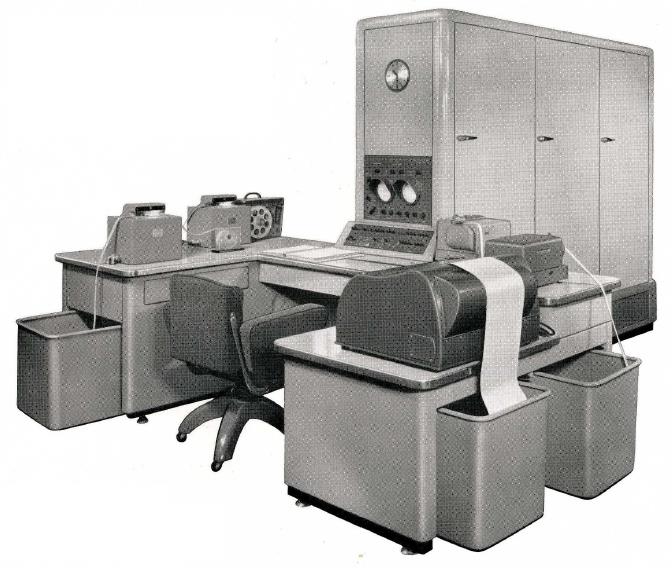
The Ferranti Pegasus, illustrated above, was an early British computer, from 1956, which introduced the important concept of general registers to computing. It had eight registers, the last seven of which could be used as index registers as well as accumulators: as with some subsequent computers, as the registers were wider than needed to contain an address, index values also included an increment field. It also had a small delay-line memory; while program steps were read directly from its drum memory, arithmetic was done with numbers in the delay-line memory only.
The later Ferranti Mercury was a computer that used core memory.
The IBM 650, announced on July 2, 1953, was also, at the time, a low-cost computer in IBM's lineup, and one account notes that it was the first computer to be mass-produced (although that honor has also been claimed for other computers), and also the first one to be significantly profitable for IBM. The Bendix G-15 computer, from 1955, was relatively inexpensive, and it was used by a number of engineering firms; the company, at one point, celebrated selling their 100th unit of this computer. It was designed by Harry Huskey, who had previously worked with Alan Turing on the Pilot ACE computer. The Royal-McBee LGP-30 was another drum-based vacuum tube computer; it was slightly less expensive than the Bendix G-15, but did not offer the same level of expandability. A later model, the Librascope LGP-21, was even less expensive, at the cost of being considerably slower, despite being introduced in 1963, nine years later than the LGP-30 from 1954, and being made from transistors instead of vacuum tubes.
Below are photographs of the IBM 650 and the Bendix G-15:
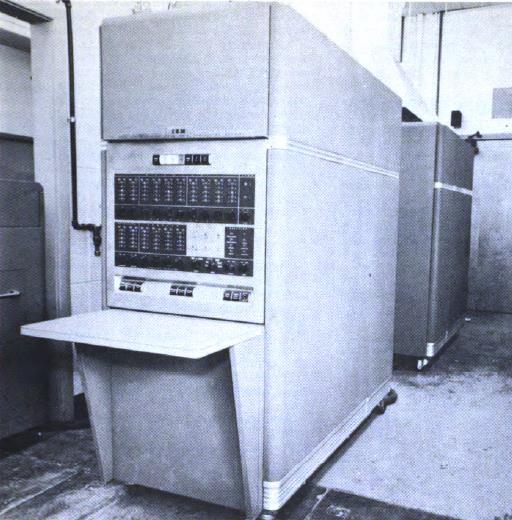
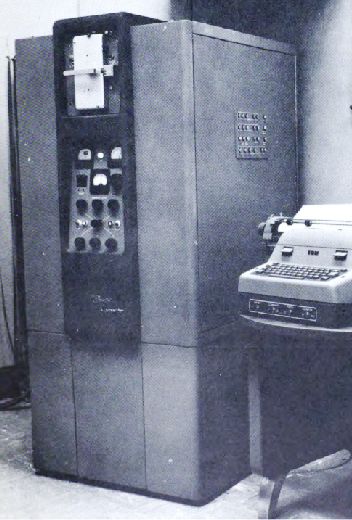
And here is a photograph of the LGP-30:
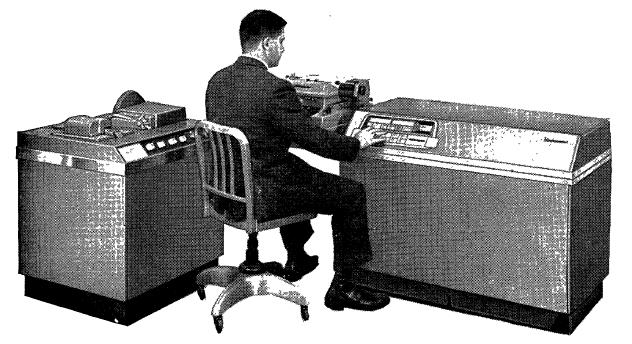
The IBM 650 was simpler to program in at least one way, as in that computer, unlike the Bendix G-15 and the Royal-McBee LGP-30, the next address field in each instruction contained a complete address, not simply the position of the next instruction on the current track. However, in practice, this would not be a significant advantage, because optimum programming, placing the next instruction an appropriate distance ahead on the drum, corresponding to the time the previous instruction would take to execute, was automatically carried out for the programmer by the available assembly language programs for each machine.
Initially, the only peripheral that connected directly to the IBM 650 was a card reader-punch, and so, for example, in order to generate a printout from it, the text to be printed first had to be punched on cards, but this lack was remedied during the lifetime of the system.
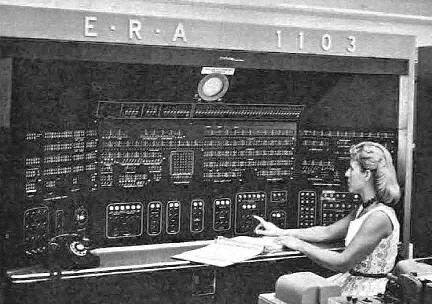
The Univac 1103 computer, announced in February 1953, had a 36-bit word, and supplemented a drum memory of 16K words with a random-access Willams Tube memory of 1,024 words. They shared the same address space. The image shown at right is of an 1103 made by Engineering Research Associates before it was acquired by Univac, at the NASA Ames Research Laboratory. The 1103 was succeeded by the Univac 1103A, announced in March, 1956, which also had a drum memory of 16K words, but which used core memory to supplement it; up to three banks of 4,096 words could be used with the computer. Floating-point hardware was available as an option for the Univac 1103A. The 1101, 1102, 1103, and 1103A were also sometimes labelled the Univac Scientific.
Having even a small random-access memory allowed that computer to avoid including a next instruction address in each instruction, and also to largely avoid the need to write programs around when data would be available, while still taking advantage of the fact that drum memory was less expensive.
The magnetic core memory, initially used in the Whirlwind computer prototype, the AN/FSQ-7 computer used for air defense, and the commercial IBM 704 scientific computer, allowed computers to be built which, because they now had dependable memories that were random access in nature, followed the same general model of programming that applied to nearly all computers made subsequently, right up to the present day; of course, though, the same would apply to computers with Williams Tube memory, also random-access in nature, even if this form of memory had reliability issues, which were eventually determined to be due to pattern sensitivity.

The IBM 701, also known as the Defense Calculator, was announced on May 21, 1952; it had an 18-bit word and a relatively simple instruction set. The front panel of one is pictured at left. It looks quite similar to that of the IBM 704, which we will see below.
The instruction set did not include a special instruction to facilitate looping, so addition and conditional branch instructions had to be used instead; and even more seriously, the instruction set did not include a subroutine call instruction. This computer used Williams Tube memory.
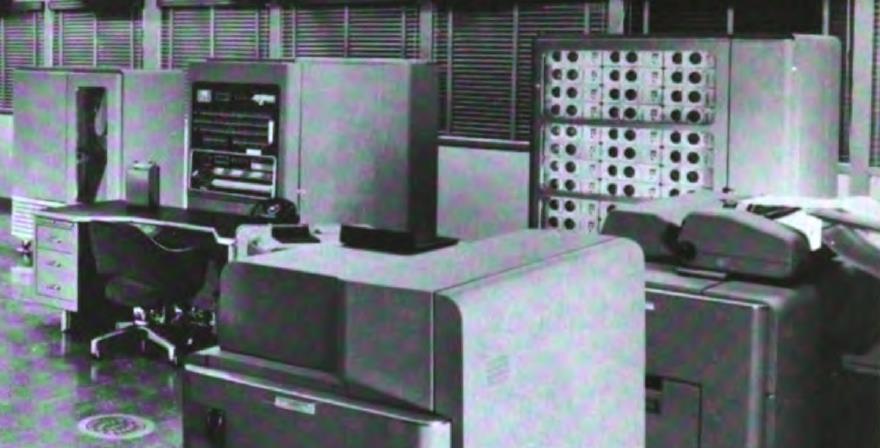
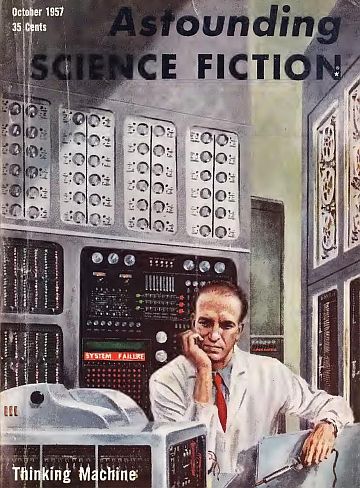
The image above, a detail from a photograph of an IBM 701 installation at General Motors, shows, among other things, in the background the console of the IBM 701 computer, and its Williams Tube memory, with two tubes in a module, three modules across, and four modules high in each of at least three groups of modules stacked vertically.
To the right is an image of the front cover of the October, 1957 issue of Astounding Science Fiction magazine. This cover is sometimes said to have been inspired by the IBM SSEC; looking closely at it, I'm not sure that I see much of a resemblance; but at the top of the left-hand portion of the machine, one can clearly see something that appears to have been inspired by the Williams Tubes of the IBM 701.
Incidentally, the cover painting for this issue of Astounding Science Fiction is the work of noted science-fiction artist Ed Emshwiller.
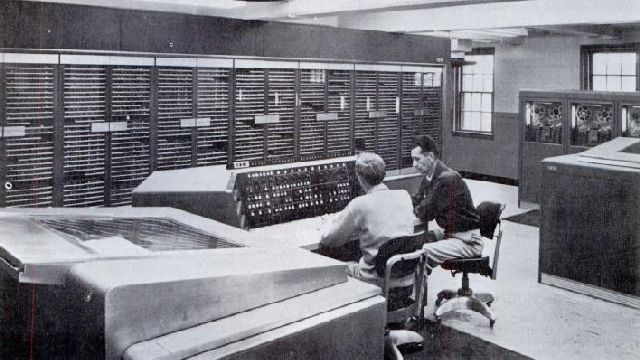
The Naval Ordnance Research Calculator (NORC), pictured above, formally transferred to the U.S. Navy on December 2, 1954, but not physically moved from the Watson Laboratory to the Naval Proving Grounds at Dahlgren, Virginia until the following year, initially used Williams Tube memory, but was converted to core memory in March, 1960. The NORC was not decommissioned until 1968, and according to one source, is believed to have been the most powerful computer in existence until 1963, when, presumably, the transistorized Control Data 6600 displaced it. However, I am skeptical of this; what about the Control Data 1604 from 1959, or the STRETCH from 1961?
In any case, it certainly was a powerful computer in its day, and has been referred to as "the first supercomputer". Also, it should be noted that this computer performed decimal arithmetic rather than binary, despite being used for a scientific workload instead of a commercial workload.
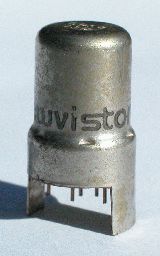
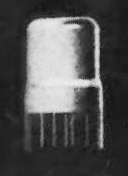
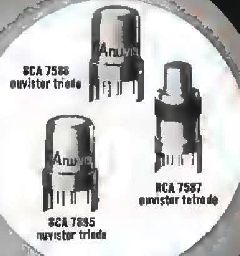
Incidentally, in 1959, RCA brought out the Nuvistor. The example pictured immediately to the left of this paragraph has a body only half an inch high, with the pins extending a further 3/16 of an inch. Beyond that image, further to the left, is a much better photo of a Nuvistor, released into the public domain by John Rewinkel. These ultra-miniature vacuum tubes were originally designed for the tuners of RCA New Vista color television sets, but they were also made available by RCA for use in other electronic devices, as illustrated by the image on the right, from an advertisement for three Nuvistors designed to satisfy MIL-SPEC requirements that were available from RCA.
As vacuum tubes are significantly more resistant to radiation than transistors, Nuvistors were used in the Ranger probes sent to take photographs of the lunar surface.
Since transistors were already available in 1959, however, as far as I am aware this attempt to improve the vacuum tube and make it more competitive with the transistor did not result in any computers being built with Nuvistors instead of either other tubes or transistors. But the Nuvistor does illustrate that the transition from vacuum tubes to transistors was not entirely abrupt.
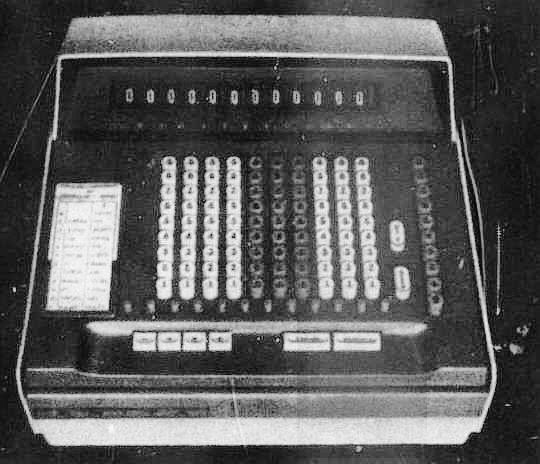
 |
The image above is from Wikimedia Commons, licensed under the Creative Commons Attribution Share-Alike 3.0 Unported License, and is thus available for your use under the same terms. Its author is MaltaGC. |
And, while meditating on the unrealized possibilities of the vacuum tube, it may also be noted that the Bell Punch company in Britain designed a desktop calculator from vacuum tubes, which they sold through their Sumlock Comptometer division. An image of this calculator from one of their advertisements is shown at left. Of course, much nicer images are available elsewhere on the Web, and since permission was availble to use one of them, I've placed it at the right. (Of course, if your browser window is not sufficiently wide, you may see it above or below.)
During the time when computers were made from vacuum tubes, IBM developed the vacuum column, which significantly improved the performance of magnetic tape drives by allowing the tapes to start and stop moving more quickly.
An even more significant IBM innovation in magnetic storage of data was its invention of the hard disk drive. Initially, IBM's first hard disk drive was part of a system including a computer especially constructed to make use of it; the system was called the IBM 305 RAMAC, for Random Access Method of Accounting and Control. It was first made available on September 14, 1956. This computer is pictured below:
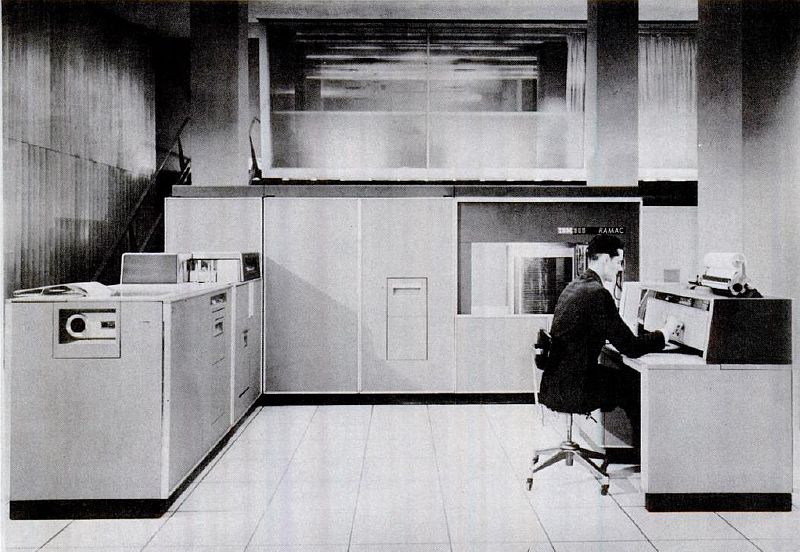
The disk drive is on the right-hand side of the cabinetry in the back, and is behind the operator seated at the computer's console.
The capacity of the hard disk drive in this machine was 5,000,000 characters (the RAMAC 305 computer used decimal arithmetic) but the characters were six bits long, and so this disk drive had about 3/4 of the capacity of a 5 megabyte disk drive, the most common size for early microcomputer hard disk drives.
One limitation it had, compared to the modern hard disk drive, was that although it had multiple platters, it only had a set of two arms with read/write heads, one for the top surface, and one for the bottom surface, of a platter, and these two arms were mechanically moved up or down to the platter desired to be used.
IBM quickly responded to the demand to make this powerful storage capability avaiable with their other computer systems. Thus, next the IBM 650 RAMAC system became available:
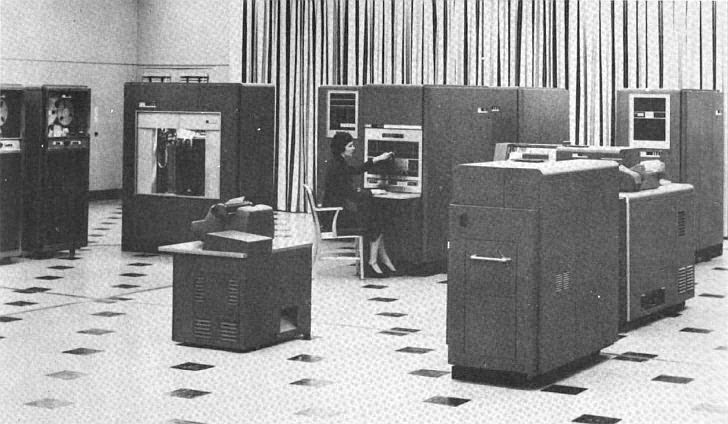
Here, the disk drive is in its own free-standing unit, on the left side of the photo, just to the right of a row of tape drives, two of which are visible.
And here is a similar hard disk drive, now connected to the solid-state IBM 1410 computer:

For this computer, the hard disk drive was available in two sizes, one containing 10 million characters, and one with the capacity doubled to 20 million characters.
Later, a modified version of this disk drive, with the modern arrangement of an arm with a read/write head for every surface, which was still very similar in appearance, was developed. It was available for the IBM 7090 computer, for example, as the IBM 1301 disk storage unit.
One of the last vacuum-tube computers ever made, from 1962, notable for having what was perhaps the largest front panel of any computer ever (except, of course, for that of the AN/FSQ-7), was the Ballistic Research Laboratories Electronic Scientific Computer, pictured below:
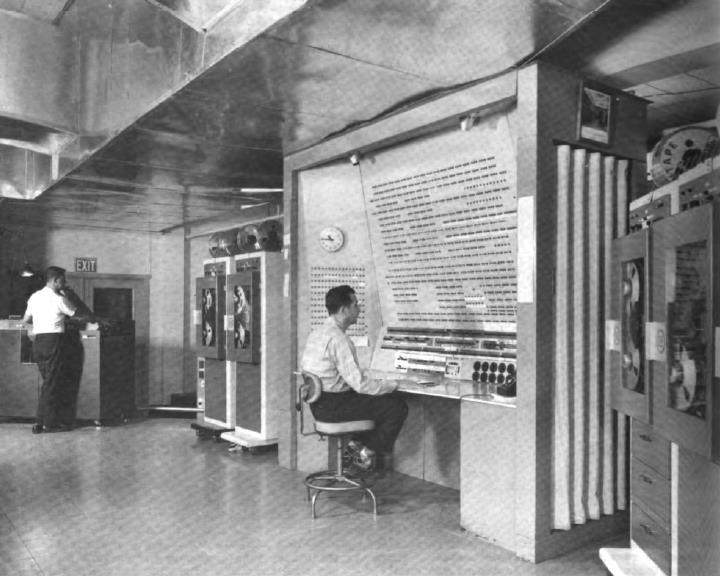
It had a word length of 72 bits, with 4K words of core memory, and an additional 24K words of memory on two drum memories sharing the same address space. It also included hardware floating-point capabilities, following the lead of the IBM 704.
The individual seated at the console of the computer is Lou Moeller, and the one in the background is Horace Burkintere, I have learned.
Of course, the acronym chosen for it was memorable, the word burlesque having originally meant a broad satire, but having come to be associated with a type of vaudeville show featuring striptease performances.
Incidentally, much later, a BRLESC II computer was made, built with integrated circuits; but I will include its photograph on this page:
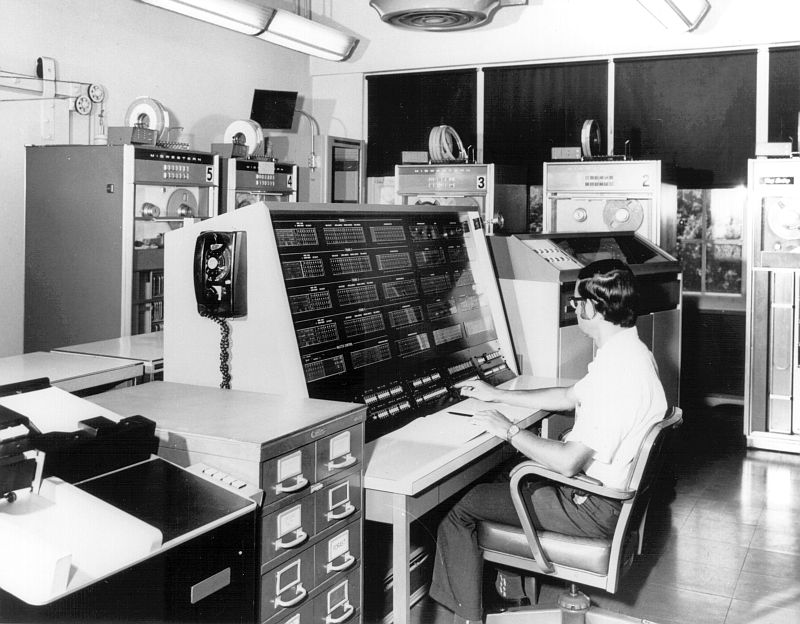
I had to do some image processing on the PNG image available on a U.S. army image archives site to make the front panel lights visible. Again, the identity of the individual seated at the console has been preserved; he is Alexander V. Kurian.
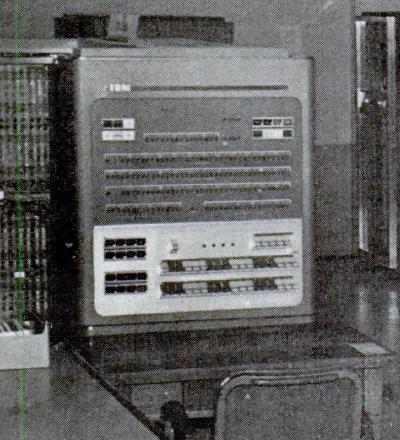
The IBM 704 computer was introduced on May 7, 1954. It is pictured at left. It was the first computer to include both indexing and hardware floating-point as standard features rather than options, and, even more importantly, the first computer sold commercially to have core memory.
It performed single-precision floating-point arithmetic in hardware; as well, its single-precision floating-point arithmetic instructions retained additional information, normally generated in the course of performing addition, subtraction, or multiplication, that allowed programs to perform double-precision arithmetic to be short and efficient. (This was also true of several other computers that provided single precision, but not double precision, in hardware that came afterwards; the PDP-6 and PDP-10 computers are one example of this, as hardware double precision was not introduced to that architecture until the KI10 chassis for the PDP-10.)
IBM developed the first FORTRAN compiler for the IBM 704. Higher-level languages existed before FORTRAN, but because this compiler was designed to generate highly optimized code, it overcame the major objection to higher-level languages, that they would be wasteful of valuable computer time.
The original FORTRAN compiler for the IBM 704 lacked one basic feature, the ability to write subroutines. However, sections of code that could be used in multiple places in a program were still possible, using a feature of FORTRAN known as the "assigned GO TO". This was a GO TO statement which could have multiple targets. A different FORTAN statement, the "computed GO TO", worked like ON... GOTO in BASIC, allowing one to pick a target from a list using an index. In the "assigned GO TO", however, the parameter in the statement had to be set using a special statement, the ASSIGN statement. Presumably, this integer variable would, in most implementations, contain the address of the destination for the assigned GO TO being chosen.
FORTRAN II, which became available later for the IBM 704 as well, remedied the limitations of the orignal FORTRAN compiler, and was a reasonably complete language, although still old-fashioned.
IBM later came out with a more modern version of FORTRAN, FORTRAN IV, for the IBM 7090, but the compiler offered for this language did not optimize as well as the FORTRAN and FORTRAN II compilers. Later, for System/360, IBM made available two FORTRAN IV compilers, one of which, the FORTRAN IV level H compiler, offered advanced optimization.
The introduction of FORTRAN for the 704, of course, still further cemented its position as the forerunner of how computers appeared and behaved since that time. For example, the instruction mnemonics of the IBM 704 were all three letters long, and this was copied by most of the other computers that followed, from the SDS 9300 down to the PDP-8.
There was also an octal-decimal integer conversion table which appeared in identical form, along with a table of powers of 2 and an octal-decimal fraction conversion table, in the manuals for many of the computers in those days; I presume it must have had a public-domain source, which I have not yet found, since the versions in the IBM 704 manual from 1955, the SDS 910 reference manual from 1966, the manual for the CDC 924 from 1962, the Digital Equipment Corporation Small Computer Handbook from 1967 (although in this case, one of the three tables, the table of powers of two, was re-typeset), the manual for the SCC 660 (again, the powers of two were re-typeset, and, as well, it was shortened) all seemed to have been photographically reproduced from the same source.
The manual for the CDC 1604 included the three tables, identical in layout, but all three were re-typeset, unlike the case for the CDC 924.
The fact that its entire memory was random-access core memory, and that it had an extensive instruction set, along with having a higher-level language available meant that, despite being made from vacuum tubes, it was, in many important respects, a fully modern computer. Of course, except for FORTRAN, for the most part this would also have applied to the handful of computers before it that also had random-access memory.
Another historical claim to fame of the IBM 704 was that it was used for the first experimental programs to play both chess and checkers. The chess program, written by Alex Bernstein, had two predecessors that didn't quite qualify; one by Alan Turing which was only executed by hand, and one written for the MANIAC I which played a modified version of chess on a smaller board without Bishops. The checkers program, written by Arther Samuel, had an additional valuable feature; it improved its own play by learning from the results of games it played.
The IBM 704 could have a core memory of 4,096, 8,192, or 32,767 words in size. A drum memory unit with a capacity of 8,192 words of 36 bits was available for the IBM 704 as an optional peripheral device; one or two of them could be attached to the 704.
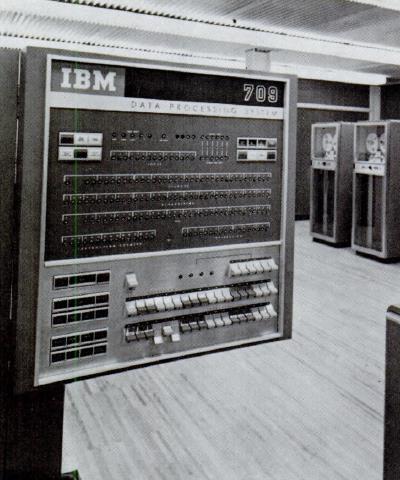
A successor to the IBM 704 was made, also based on vacuum tubes, the IBM 709, pictured at right. This computer had a considerably expanded instruction set. However, not many of those were made, as it ended up being replaced by the IBM 7090 computer, which had exactly the same instruction set, but which was implemented using transistors. For many years, the IBM 7090 was widely used by those who needed a powerful scientific computer.
One early vacuum-tube computer was so significant that I placed a number of images of it on these pages, and so I've put the Selective Sequence Electronic Calculator on a page of its own.